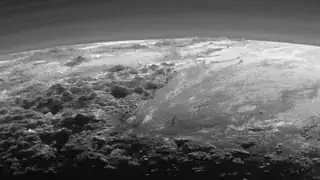The unit of illumination is the lux, lumens per square meter.
- What is the minimum lux required for reading?
- How many lux does the Sun provide at distance D?
What is the minimum lux required for reading?
You can plug all sorts of numbers into this depending on how good your eyes are, how big the print is, and how close you hold it to your face. I'm going to use civil twilight which is 3.4 lux. Others may like 1 foot-candle, 1 lumen at one foot, or about 10.764 lux. Whatever value you prefer, you can plug it into the formula below.
How many lux does the Sun provide at distance D?
To calculate the lux the Sun puts out we first have to calculate how much solar radiation (raw energy) it puts out at distance D? You take the luminosity of the Sun and distribute it over the surface of a sphere of radius D.
$$ \text{solar radiation in} \, \frac{Watts}{m^2} = \frac {3.846 \times 10^{26} W}{4 \pi D^2} $$
Not all of that is visible light. We need to convert that into lux, lumens per square meter. To do that you need to integrate the power output over the curve of visible light output using the Luminosity Function which, fortunately, someone has already done coming out with a luminous efficacy of 93 lumens per W.
$$ \text{illumination in lux at} \, D = \frac{93 \frac{lumens}{W} \times 3.846 \times 10^{26} W}{4 \pi D^2} $$
At the Earth where $ D = 1.5 \times 10^{11} \, m $ we get $ 1.27 \times 10^{5} \, lux $. This is higher than direct sunlight at the Earth's surface because it does not account for atmosphere. This is good because New Horizons is in a vacuum.
How many lux are available to New Horizons?
Pluto is currently 32.6 AU from the Sun, or $ D = 4.89 \times 10^{12} \, m $. Plugging that in we get $ 1.19 \times 10^2 $ or $ 119 \, lux $. Plenty!
Or is it? That's how much light New Horizons is receiving from the Sun, but how much is bouncing off Pluto? Pluto has an albedo of about .6 so a little more than half the Sun's light is reflected back to New Horizons, or about 70 lux which is about the same as your average office hallway. Not great, but plenty for a long exposure.
This paper on LORRI agrees, "At Pluto encounter, 33 AU from the Sun, the illumination level is ~1/1000 that at Earth".
How far out from the Sun is visible light still sufficient to read a book?
We need to solve for D.
$$ I = \frac{93 \frac{lumens}{W} \times 3.846 \times 10^{26} W}{4 \pi D^2} $$
$$ I D^2 = \frac{93 \frac{lumens}{W} \times 3.846 \times 10^{26} W}{4 \pi} $$
$$ D^2 = \frac{93 \frac{lumens}{W} \times 3.846 \times 10^{26} W}{4 \pi I} $$
$$ D = \sqrt{ \frac{93 \frac{lumens}{W} \times 3.846 \times 10^{26} W}{4 \pi I}} $$
Plug in $I = 3.4 \, lux$ and get $D = 2.8 \times 10^{13}$ or $186 AU$ which puts us past the Kuiper Belt and well into the Scattered Disc.
When using a different number for reading light note that lux changes with the square root of the distance. If you double the lux required you decrease the distance by 1.4. If we triple I to 10 lux (aka the foot-candle), the distance drops by 1.7 to about 108 AU. Still very far out.
Could we expect colors at this distance?
At Pluto you will see colors fine. At 186 AU you will see colors about as well as you can see colors at civil twilight.
New Horizons has two instruments measuring visible light. LORRI is a long range panchromatic camera, meaning it acts like a regular digital camera and captures an approximation of what the human eye sees.
The other is the Ralph telescope. It is a multispectral visible and infrared imager meaning it takes multiple images at several different wavelengths. These will appear grey, the grey is a measurement of the light intensity at a specific wavelength. This is usually how spacecraft "see" color because scientists aren't interested in pretty pictures with multiple wavelengths smeared together, they want data about specific wavelengths. NASA public relations people mix the images together to approximate what matches what the human eyeball would see for press releases. They can't always get it quite right. Phil Plat discusses it in detail with the Mars landers.
To make these single-filter images into a color composite is not easy. If the red filter lets in less total light than the blue, you need to compensate for that when you add the images together. If the red filter is wider (lets in a wider range of reds) than the blue filter, you have to compensate for that, and so on.
Short version: pictures from LORRI are closer to what you would see than from Ralph.
